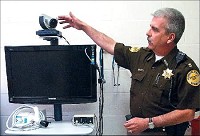



Feature Story
More feature stories by year:
2024
2023
2022
2021
2020
2019
2018
2017
2016
2015
2014
2013
2012
2011
2010
2009
2008
2007
2006
2005
2004
2003
2002
2001
2000
1999
1998
Return to: 2011 Feature Stories
CLIENT: AMERICAN EDUCATIONAL TELECOMMUNICATIONS![]()
Feb. 11, 2011: Norfolk Daily News
 Capt. Terry Kotrous, administrator at the Madison County jail, shows off the jail's telemedicine system. By using the American Educational Telecommunications (AET) machine, inmates no longer have to be transported to the doctor for a visit. |
Taxpayers can thank technology.
It's saving them money when it comes to the medical care of inmates at the Madison County jail.
The jail started using an American Educational Telecommunication (AET) machine for inmates' health care in late 2009. Just by looking at budget receipts, the savings have been significant.
In 2008-09, more than $226,000 or more than 16 percent of the jail's budget, was spent on inmates' doctor's visits, hospital stays and prescriptions. In 2009-10, that number dipped to just over $100,000, or 8 percent of the budget.
Other factors may play into the decrease, but there's no doubt that AET had a role, said Capt. Terry Kotrous, administrator of the Madison County jail.
AET is based in Norfolk with an office in Omaha and was started by Dr. Keith Vrbicky of Midwest Health Partners. The jail has been using Midwest Health Partners for telemedicine for the past four months.
Kotrous said Midwest Health Partners is a good fit because it has doctors on staff until 11 p.m. and on-call staff who can help whenever an inmate health matter arises.
"As far as we know, we're the first in the state doing this from a county jail like this," Vrbicky said. "We're wanting to expand into all the county jails and into the state prison system."
By using the AET machine, inmates no longer have to be transported to the doctor for a visit. The AET machine includes tools with cameras that give views of the ears, eyes and throat. The patient can speak with the doctor and the doctor can view the patient for physical symptoms.
The AET machine also can monitor blood pressure, pulse and oxygen levels and is used by the jail's full-time nurse.
Of course, if the doctor can't make a concrete diagnosis through telemedicine, at that point an in-person appointment can be made for the inmate.
Vrbicky said the doctor is able to make the diagnosis using the AET machine 80 percent of the time.
"We used to make a lot of transports to the doctor just for small things that he couldn't see over the telephone," Kotrous said. "Now it's only for emergencies and high-profile things that we take to the doctor."
Not only does that save on transportation costs, but it also saves jail staff time on accompanying the inmate to the doctor.
The security risks also dramatically reduce when you can use telemedicine instead of transporting an inmate.
"Every time you take an inmate out of a secure area, that risk and that chance goes up. It could be a set-up where an inmate has faked an illness and tried to escape because they figure there's lack of personnel," Kotrous said. "It's always a risk. This way, it's a little more secure."
Although some inmates are covered under Medicaid, Medicare or even have their own personal insurance, most of the health care expense become the county's burden.
And inmates are not without major medical issues.
At any given time, there's inmates going through withdrawal from drugs and alcohol. There's the mental health issues that go along with drug and alcohol dependence, too.
There are also quite a few inmates who are diabetics.
"Everything from that down to in-grown toenails. There's just about everything. Just like life on the street," Kotrous said.
He's able to see a significant difference in inmates after they've been in jail for a while with the regular health care they receive.
"You can see it when they first come through the door. They're weak, not really taking care of themselves. You get them regulated, they're showing signs of color, energetic. . . . People receive some really good treatment while they're here," he said.
And there are ways to provide good care and still keep costs down, Kotrous said.
"If we can set it up on telemed, it saves the taxpayers a lot of money," he said.
Return to: 2011 Feature Stories